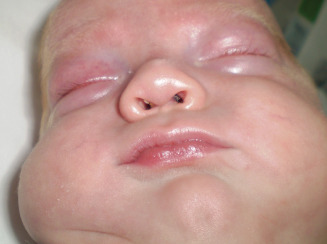Dear Editors,
We present a case of nasal injury secondary to nasal continuous positive airway pressure in a 28‐week‐preterm infant, hospitalised in the neonatal intensive care unit of our hospital.
After having applied a nasal continuous positive airway pressure (NCPAP) device at 4 weeks of birth, the infant showed a loss of cutaneous substance at the level of nasal columella with partial exposure of the underlying cartilaginous structures (Figure 1).
Figure 1.

Pre‐treatment facial view of patient shows nasal injury due to NCPAP: presence of loss of cutaneous substance at the level of columella with partial exposure of the underlying cartilaginous structures.
NCPAP is a non‐invasive form of ventilation that is becoming increasingly popular as a method of respiratory support in the newborn and, more recently, as a primary mode of respiratory support for preterm infants with respiratory insufficiency (1). In our patient, the use of the NCPAP device was absolutely necessary: when we moved it away from the nares of the infant, there was a sudden decrease in PO2.
One of the complications of NCPAP application is nasal injury, ranging from oedema to columella necrosis, which may occur with all types of nasal prongs and NCPAP devices 2, 3, 4. The major underlying mechanism of nasal injury related to NCPAP appears to be the pressure generated on the columella by the prongs. Current available interfaces are too rigid, oversized or too heavy for smaller infants. Increased pressure on the columella causes diminished circulation of blood flow. This subsequently impairs tissue perfusion and leads to ischaemia along with tissue damage. Persistent erythema, dermal injury, oedema, induration and finally an ulcer can occur (3). So relieving the pressure is the key to healing and more importantly, the key to prevention.
Weng (4) found that refining materials used in non‐invasive (NIV) masks with polyurethane hydrocolloid dressings applied to prevent pressure ulcers can reduce face mask lesions and increase tolerance to NIV. Günlemez et al. (3) reported that nasal silicon shield application not only reduced the nasal injury rates significantly, but also decreased the severity of nasal injury.
Based on our experience in the treatment of columella pressure ulcer, we propose daily disinfection of the lesion with a highly diluted solution of sodium hypochlorite (0·5% w/v) with topical anti‐infective activity (Dakin's solution) followed by thorough cleansing with normal saline in order to avoid hystotoxicity and application of topical cream containing hyaluronic acid sodium salt. HA above all generates a microenvironment stimulating the secretion of growth factors, proliferation and migration of fibroblasts, endothelial cells, keratinocytes and angiogenesis, and it has a positive effect on the inflammatory response (5). After 3 weeks of local therapy, at the last clinical visit we observed an improvement in the region of columella with re‐epithelialisation at the level of the loss of cutaneous substance (Figure 2).
Figure 2.

Post‐treatment facial view of patient shows an improvement in the region of nasal columella with local re‐epithelialisation.
Regarding prevention of columella pressure ulcers, our most important advice is to periodically check the region of columella in these young patients. When first‐grade lesions are already present, we recommend the usage of protection devices not only to avoid formation of pressure ulcers but also to reduce the severity of nasal injury, as in our case. In particular, we suggest creating a cushion made of gauze pad containing hyaluronic acid sodium salt and applying it around the nasal cannula for oxygen‐therapy with the aim of reducing the pressure on columella, distributing pressure around the nares and reducing friction between the device and skin: it is essential for the prevention of tissue damage.
References
- 1. Mahmoud RA, Roehr CC, Schmalisch G. Current methods of non‐invasive ventilatory support for neonates. Paediatr Respir Rev 2011;12:196–205. [DOI] [PubMed] [Google Scholar]
- 2. Millet V, Lacroze V, Bartoli JM, Unal D. [Necrosis of the nasal columella secondary to nasal continuous positive airway pressure]. Arch Pediatr 1997;4:485. [DOI] [PubMed] [Google Scholar]
- 3. Günlemez A, Isken T, Gökalp AS, Türker G, Arisoy EA. Effect of silicon gel sheeting in nasal injury associated with nasal CPAP in preterm infants. Indian Pediatr 2010;47:265–7. [DOI] [PubMed] [Google Scholar]
- 4. Weng MH. The effect of protective treatment in reducing pressure ulcers for non‐invasive ventilation patients. Intensive Crit Care Nur 2008;24:295–9. [DOI] [PubMed] [Google Scholar]
- 5. Hollander D, Schmandra T, Windolf J. Using an esterified hyaluronan fleece to promote healing in difficult‐to‐treat wounds. J Wound Care 2000;9:463–6. [DOI] [PubMed] [Google Scholar]


